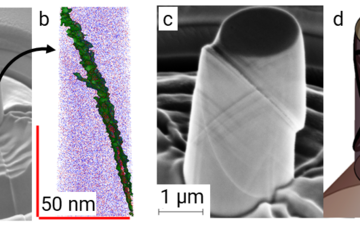All genres
181.
Talk
Spatially Correlated TEM, EBSD and APT Analysis. SFB 761 Klausurtagung, Bad Neuenahr, Germany (2012)
182.
Talk
Atomare Analyse von Konzentrationsänderungen an Grenzflächen mittels Atomsonde. SFB 761 Vollversammlung, RWTH Aachen, Germany (2012)
183.
Talk
Atomic Analysis of Concentration Changes at Interfaces by Atom Probe Tomography. SFB 761 Doktorandenseminar, RWTH Aachen, Germany (2011)
184.
Poster
Building a Library of Simulated Atom Probe Data for Different Crystal Structures and Pillar Orientations Using TAPSim. APT&M 2018 International Conference on Atom-Probe Tomography & Microscopy, Washington, DC, USA (2018)
185.
Poster
Off-stoichiometric composition of κ carbide in Fe–Mn–Al–C steels: An ab-initio study combined with experiment. ADIS 2016 Workshop, Tegernsee, Germany (2016)
186.
Poster
A Sample Holder System that Enables Sophisticated TEM Analysis of APT Tips. International Field Emission Symposium 2012, Tuscaloosa, AL, USA (2012)
187.
Poster
Segregation-Induced Phase Transformation on Grain Boundaries in Fe–Mn. TMS 2012, Solid-State Interfaces II Symposium, Orlando, FL, USA (2012)
188.
Thesis - Habilitation
Hüftimplantate: Ein werkstoffwissenschaftlicher Blick auf Geschichte, Möglichkeiten und Limitationen. Habilitation, RWTH Aachen University (2021)
189.
Thesis - Master
Atomic scale analysis of grain boundary segregation in pearlitic steel. Master, Escuela Superior Politécnica del Litoral, Guayaquil, Ecuador (2017)











